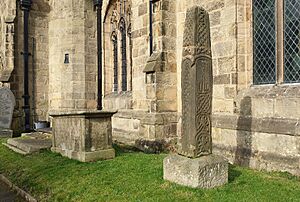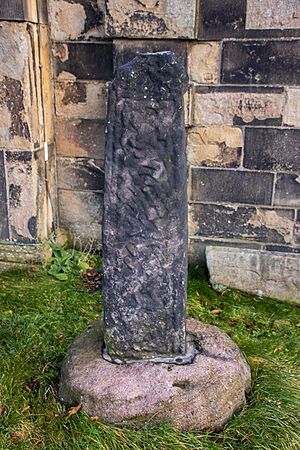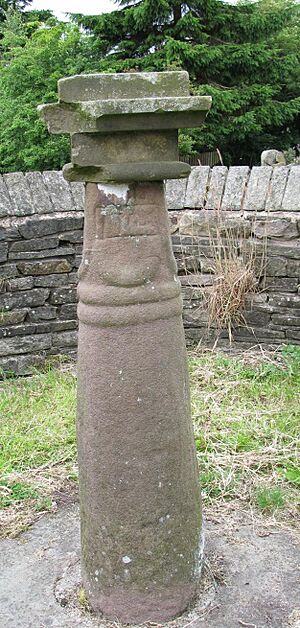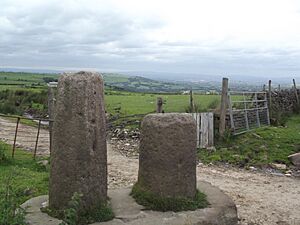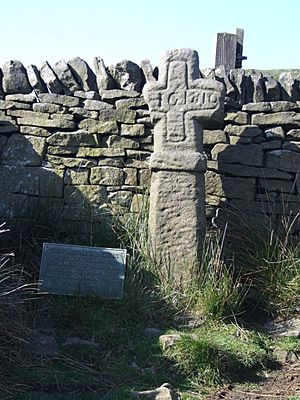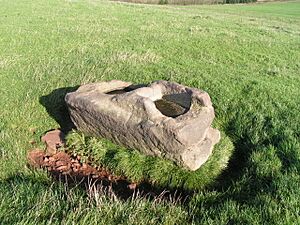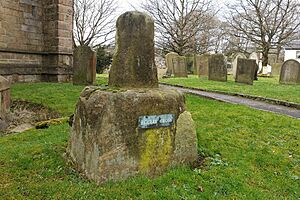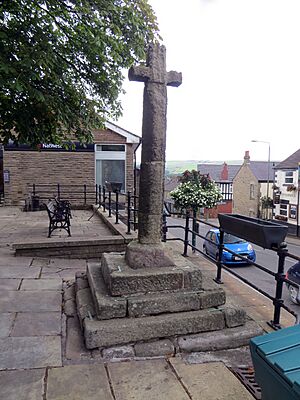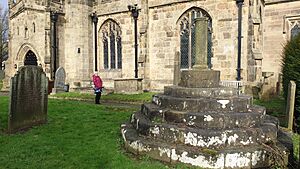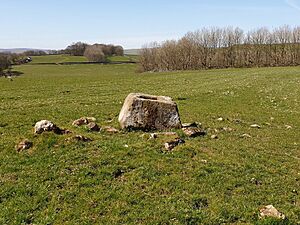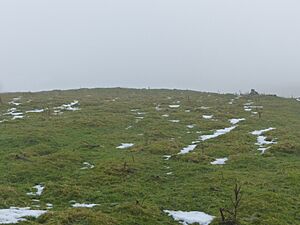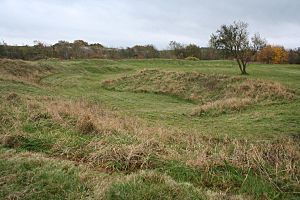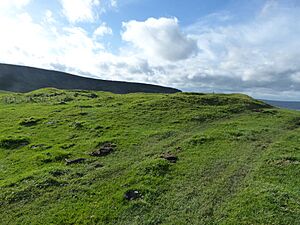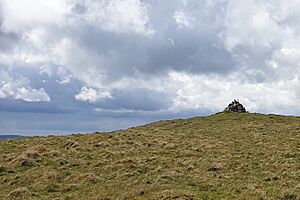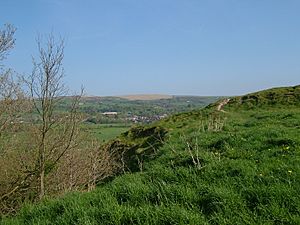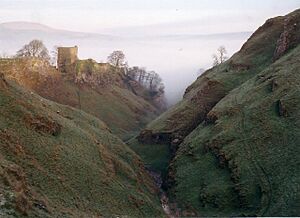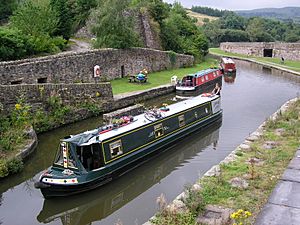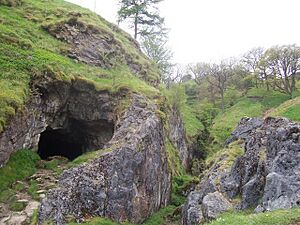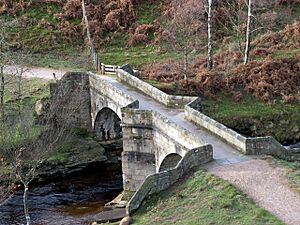Scheduled monuments in High Peak facts for kids
This is a list of scheduled monuments in the district of High Peak in the English county of Derbyshire.
A scheduled monument is a really important old place or building in the United Kingdom. These places are protected by the government so no one can change them without permission. English Heritage is a group that helps find and protect these special sites. There are about 20,000 scheduled monuments on the list. Sometimes, one entry can even include more than one site!
Even if an old building is also a "listed building" (which means it's important for its history or looks), English Heritage often thinks being a listed building offers better protection. If a monument is no longer considered important enough, it can be taken off the list.
Derbyshire has over 500 scheduled monuments. These include many stone piles (called cairns), stone circles, old burial mounds (barrows), remains from lead mining, ancient villages, and more than 20 bridges.
Contents
Discovering High Peak's Ancient Treasures
High Peak is full of amazing historical sites. Let's explore some of the most interesting ones!
Ancient Crosses and Stones
Many old stone crosses stand in High Peak, showing art and history from long ago.
Hope's Anglian Cross
You can find an Anglian high cross in the churchyard of St Peter's Church, Hope. This cross is from the 9th century. It is made of gritstone and has beautiful Celtic designs. It is also a Grade II listed building, meaning it's important for its special architecture.
Chapel-en-le-Frith Crosses
In the churchyard of St Thomas Becket Church, there is an Anglo-Scandinavian high cross. It is also a Grade II listed building. Another standing cross is also found in this churchyard.
Shall Cross at Whaley Bridge
The Anglo-Scandinavian high cross, known as the Shall Cross, is in Whaley Bridge. This gritstone cross dates back to the 9th or 10th century. In the 18th or 19th century, a sundial was put on its shaft, replacing the original cross head.
Robin Hood's Picking Rods
Near Chisworth, you can find a wayside and boundary cross called Robin Hood's Picking Rods. It's a unique old stone with a fun name!
Other Important Crosses
* The Edale Cross is another wayside and boundary cross found near Hayfield.
* The Dipping Stone is a wayside and boundary cross in Whaley Bridge.
* The Eccles Cross, from the 13th century, was moved to St Peter's churchyard in Hope in 1966.
* A market cross in Chapel-en-le-Frith is also a Grade II listed building.
* Another standing cross is in the churchyard of St Peter's Church, Hope.
* The Wind Low bowl barrow in Wormhill has the base of a medieval standing cross.
Ancient Burial Mounds and Circles
Many old burial sites and mysterious stone circles dot the landscape of High Peak.
Anthony Hill Bowl Barrow
Near Buxton, you can find the Anthony Hill bowl barrow. This burial mound likely dates back to the Bronze Age. In 1851, a small dig found a boar's tusk and some human bones here.
The Bull Ring Henge
The Bull Ring henge in Dove Holes is a Neolithic circular earthwork. It's about 50 meters across with a flat center, surrounded by a ditch and a bank. There are also two burial mounds about 20 meters away from the henge.
Cow Low Bowl Barrow
In Chapel-en-le-Frith, you'll find the Cow Low bowl barrow. Another Cow Low bowl barrow, near Buxton, is a Bronze Age burial mound. When it was dug up in 1846, people found several skeletons, jet necklaces, and even signs of burials from around 700 AD.
Eldon Hill Bowl Barrow
The Eldon Hill bowl barrow in Peak Forest is a Bronze Age burial mound. Digs in the 1860s and 1870s found several human skeletons in a stone tomb.
Lismore Fields Settlement
Lismore Fields in Buxton is a very special place. It's where the first people of Buxton lived about 6,000 years ago! This Stone Age settlement was found in 1984. They discovered remains of old timber roundhouses and longhouses. One of the oldest pots ever found in Britain was also here. Lismore Fields might even be the earliest place where people grew crops in Britain.
Staden Low Earthwork
The Staden Low earthwork in Staden, Buxton, is a circular Neolithic earthwork. When it was dug up in 1926, people found a stone axe head, flint tools, pottery pieces, and deer antler fragments.
Other Burial Sites
- Two bowl barrows are on Withery Low in Wormhill.
- Two bowl barrows are on Bole Hill in Wormhill.
- The Crookstone Hill round cairn is in Hope.
- The Cowdale Oval Cairn in King Sterndale, Buxton, is one of two cairns. It's Neolithic in shape, and digs found a polished flint axe and human remains.
- The Eldon Hill bowl barrow in Peak Forest is a Bronze Age burial mound.
- The Fox Low bowl barrow in Buxton is a Bronze Age burial mound. It was partially dug up in 1850 and contained human remains.
- The Gautries Hill bowl barrow is in Peak Forest.
- The Green Low ringcairn is in Chapel-en-le-Frith.
- The Harrod Low long barrow is in Peak Forest.
- The Hollins Hill bowl barrow is in Hartington.
- The Hordron Edge stone circle is near Derwent.
- The Kinderlow bowl barrow is in Hayfield.
- The Lady Low barrow is in Chapel-en-le-Frith.
- The Lord's Seat bowl barrow is in Edale.
- The Ox Low oval barrow is in Peak Forest.
- The Perry Dale bowl barrow and long barrow are in Peak Forest.
- The Pike Low bowl barrow is in Derwent.
- The Ring cairn on Bamford Moor is near Lydgate Farm.
- A round barrow is near Peveril Castle in Castleton.
- A round cairn is near Crookhill Farm in Hope Woodlands.
- A round cairn and clearance cairn are also near Crookhill Farm.
- A round cairn at Gospel Hillocks in Cowdale, Buxton, contained human remains and burnt bones.
- A round cairn is between Coombes Edge and Cown Edge in Charlesworth.
- Two round cairns are on Bridge-end Pasture in Hope Woodlands.
- The Snelslow Plantation bowl barrow is in Peak Forest.
- A stone circle is near Crookhill Farm in Hope Woodlands.
- The Folly platform cairn is in Hope.
- The Tong bowl barrow and long barrow are in Wormhill.
- Two hlaews (pre-Christian burial mounds) are at Haslin House in Buxton. One was dug up in 1850 and contained human remains in a wooden coffin.
Forts and Settlements
High Peak has remains of old forts and places where people used to live.
Melandra Castle Roman Fort
Ardotalia (also known as Melandra Castle) is a Roman fort near Glossop. It's an important site that shows us about Roman times in Britain.
Navio Roman Fort and its nearby settlement (vicus) are in Brough-on-Noe, near Hope. This fort was first built with wood and earth around 100 BC. It was rebuilt with stone around 150 BC and used until about 350 AD. Today, you can see earth banks and ditches. Digs in 1903 found an underground room from the headquarters building.
Peveril Castle
Peveril Castle is a ruined 11th-century castle in Castleton. It overlooks the village and was once the main home of William Peverel. It is also a Grade I listed building, meaning it's very important historically.
Other Forts and Settlements
- Hope Motte is an old fort in Hope.
- A Bronze Age field system is near Bamford.
- A palisaded hilltop enclosure is near Dirt Low in Castleton.
- A promontory fort on Combs Edge, known as Castle Naze, is an Iron Age hillfort on Combs Moss near Chapel-en-le-Frith.
- A ringwork is in Castlehill Wood in Glossop.
- A Roman fortlet is near Highstones in Tintwistle.
- A Romano-British farmstead is near Ladybower Inn in Bamford.
- Another Romano-British farmstead and a charcoal burning site are near Ladybower Inn in Derwent.
- A slight univallate hillfort and two bowl barrows are on Mam Tor in Castleton.
- Thirteenth-century earthwork bank and ditch remains are part of the town defences in Castleton.
Mining History and Industry
High Peak has a rich history of mining, especially for lead and limestone.
Bugsworth Canal Basin
Bugsworth canal basin, along with its tramway, quarry, and limekilns, is in Buxworth. This site shows how important canals and quarrying were in the past.
Cowdale Quarry
The Cowdale Quarry limestone site in King Sterndale, Buxton, was a place for extracting and processing lime since the late 19th century. Its traditional, coal-fired kilns operated until 1954.
Odin Mine
Odin Mine in Castleton is thought to be one of the oldest lead mines in England. It's the oldest documented mine in Derbyshire.
Other Mining Sites
- Coalpithole Rake is a mining site near Perryfoot, close to Sparrowpit.
- The Eldon Hill crushing circle and other lead mining remains are in Peak Forest. This site was used for mining a lead ore vein called Burning Drake Vein.
- Engine Sough and its associated lead mine are in Castleton.
- Gautries Rake is a mining site in Peak Forest.
- Hill's Venture lead mine is in Peak Forest.
- How Grove Lead Mine is in Castleton.
- New Rake lead mines are in Castleton.
- Oxlow Rake lead mines are in Castleton.
- Part of Goyt's Moss colliery is near Derbyshire Bridge in Buxton.
- Peakshill or Oden sough is a mining site in Peak Forest.
- Pin Dale lead side veins are in Castleton.
- Slitherstone and Linacre lead mines and a limekiln are in Castleton.
- Watt's Grove Rake lead mines are in Peak Forest.
Other Interesting Sites
Reconstructed Packhorse Bridge
A reconstructed packhorse bridge from Derwent Hall is in Bamford, Hope Valley. When Ladybower Reservoir was built, this bridge was carefully taken apart stone by stone. It was then rebuilt at Slippery Stones, at the head of Howden Reservoir. It is also a Grade II listed building.
The Grey Ditch
The Grey Ditch is an earthwork in Brough and Shatton.
Prehistoric Standing Stone
A prehistoric standing stone is located near the triangulation point on High Neb in Bamford.
Medieval Hospital
The remains of a medieval hospital are located near Losehill Hall in Castleton.


